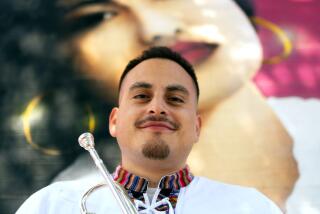Burns Fights Trumpet Bias in Brass-Roots Movement
- Share via
SAN DIEGO — Trumpet virtuoso Stephen Burns faces a double challenge. Like aspiring violinists and pianists, he has to prove his musical mettle in a crowded field. But he also has to change people’s attitude about his chosen instrument.
“My main challenge as a solo trumpet player is overcoming people’s prejudice about the instrument--that it’s loud, boorish, unmusical and raucous. I have to prove to them that it does not have a sound like shredding sheet metal,” Burns said.
Tonight and Saturday evening the 28-year-old American trumpeter will perform Hummel’s E Major Trumpet Concerto and a Torelli sonata with the San Diego Symphony.
These performances will mark Burns’ second visit to Symphony Hall this fall. In October, he soloed with the Moscow Virtuosi in Shostakovich’s Concerto for Piano and Trumpet, the only American musician playing with the touring orchestra.
Burns first encountered the Moscow Virtuosi in 1986 while playing at a summer music festival in Finland, where the Finnish director decided to put together an American player with Soviet orchestra.
“It went well, and (Moscow Virtuosi music director Vladimir) Spivakov then invited me to join their bus tour of Finland. He was putting the American tour together at the time, and he insisted I join them to play the Shostakovich concerto,” Burns said.
Performing extensively with Soviet musicians gave him some insights on how the two systems produce different musical approaches.
“The sheer quantity of their rehearsals allows them to manicure their phrases--almost like a string quartet. Largely because of union regulations, American orchestras play with more limited rehearsals, which gives them a more ‘straight ahead’ attitude about the music. The Soviet players were always changing--that’s why we rehearsed before each program.”
Burns came to appreciate the humor of his Soviet compatriots. “It was a cat and mouse game--always trying something different. In American orchestras, nobody wants to be thrown any curve balls.”
Because the solo trumpet repertory is not extensive, Burns adapts music for other instruments, champions contemporary works and creates his own multimedia compositions.
“I steal from everybody--clarinet, oboe, soprano. I’m not partial,” Burns said.
In a recent Carnegie Hall recital, he played his transcription of the coloratura soprano “Queen of the Night” aria from Mozart’s “The Magic Flute,” just to prove that the trumpet has vocal capabilities. He is among the few American trumpet virtuosi who perform Gunther Schuller’s demanding Trumpet Concerto, a piece the noted New England composer wrote for Burns’ principal mentor, Gerard Schwarz.
Most of Burns’ compositions have been collaborations with choreographer Ruby Shang, a Japanese-American dancer who specializes in site-specific dance. This summer, he and Shang mounted “Reflections,” a 45-minute piece for four musicians and 30 dancers in the plaza of New York City’s Lincoln Center. Playing the Hummel concerto with the San Diego Symphony will be a welcome change of pace for Burns. December opens the season for “Brandenburg” Concerto marathons, for which he is in much demand to play the stratospheric solo in the Second Brandenburg.
“Before Christmas, I do so many performances of the Second “Brandenburg,” they should call me Stephen Brandenburg.”
More to Read
The biggest entertainment stories
Get our big stories about Hollywood, film, television, music, arts, culture and more right in your inbox as soon as they publish.
You may occasionally receive promotional content from the Los Angeles Times.









